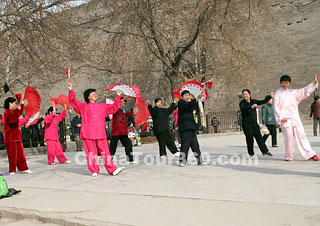Han ethnic group makes up 92 percent of the total population. According to the 1995 sample survey of 1 percent of China's population, there were 1.09932 billion Han people (an increase of 56.84 million since the Fourth National Population Census of 1990), accounting for 91.96 percent of China's total population. Han people are found in all parts of the country, but mainly in the middle and lower reaches of the Yellow River (Huanghe), Yangtze River (Changjiang), Pearl River (Zhujiang) and the Northeast Plain.
The Han people has its own spoken and written language, known as the Chinese language, which is commonly used throughout China and is the working language of the United Nations. The Han language (Chinese) belongs to the Sino-Tibetan Language System, and an be divided into seven dialects, which are the Mandarin (Standard Chinese), Wu (Shanghainese), Yue (Cantonese & Taishaneses), Gan (Jiangxinese), Min (Hokkien, Taiwanese & Teochew), Xiang (Hunanese), and Hakka. For most Han people, they are able to speak Mandarin and one or two dialects. The Hui and Manchu minority ethnic groups also use the Han (Chinese) language. The written language of the Han people is Chinese Character (Hanzi), which dates back to the Shang Dynasty (17th - 11th Century BC) over 3,000 years ago. In Mainland China, simplified Chinese is used while traditional Chinese is used in Hong Kong, Macau and Taiwan.
|
|
Traditionally, the Han people believe in Confucianism, Taoism and Buddhism. As more and more western culture is introduced to China, some Han people gradually accept the western religions, such as Christianity and Catholicism.
Rice and wheat are the staple food, plus vegetables, meat and all kinds of bean products. Rice is usually steamed and sometimes made into porridge, rice noodles, rice cake, sweet dumplings, Zongzi (made of glutinous rice) and glutinous rice cake; steamed buns, noodles, steamed twisted roll, dumping, steamed stuffed buns, Wonton, fried deep-fried dough sticks (Youtiao), spring roll and fried cakes. The cuisines of Han people are usually represented by the Eight Cuisines in China, including Sichuan, Guangdong, Fujian, Anhui, Shandong, Hunan, Zhejiang and Suzhou cuisines. Tea and liquor are two important drinks to the Han people.
The Han people celebrate traditional festivals, such as Spring Festival, Lantern, Qingming, Dragon Boat and Mid-Autumn Festivals.
Speaking of the traditional clothes of the Han people, some may think of the cheongsam or Tang suit, which are actually renovation of the clothes of the Manchu. The real Han clothes first appeared about 5,000 years ago during the Yellow Emperor period, but was disappeared because of the minority rulers during the feudal society, especially in the Qing Dynasty. Now more and more Han people realize that the Han clothes are their traditional clothes, and start all kinds of “Han Clothes Movements”.









